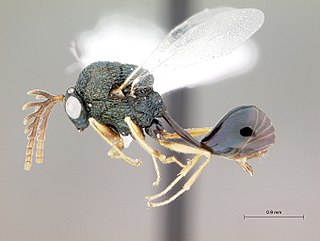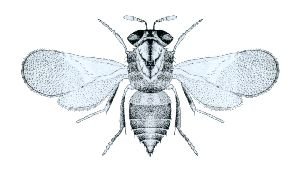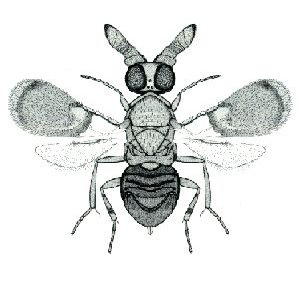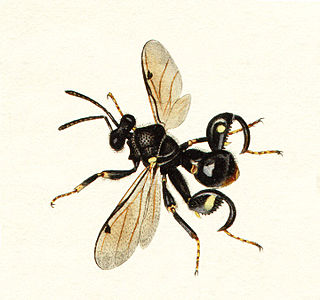
Fig wasps are wasps of the superfamily Chalcidoidea which spend their larval stage inside figs. Some are pollinators but others simply feed off the plant. The non-pollinators belong to several groups within the superfamily Chalcidoidea, while the pollinators are in the family Agaonidae. While pollinating fig wasps are gall-makers, the remaining types either make their own galls or usurp the galls of other fig wasps; reports of their being parasitoids are considered dubious.

Chalcid wasps are insects within the superfamily Chalcidoidea, part of the order Hymenoptera. The superfamily contains some 22,500 known species, and an estimated total diversity of more than 500,000 species, meaning the vast majority have yet to be discovered and described. The name "chalcid" is often confused with the name "chalcidid", though the latter refers strictly to one constituent family, the Chalcididae, rather than the superfamily as a whole; accordingly, most recent publications (e.g.,) use the name "chalcidoid" when referring to members of the superfamily.

The family Agaonidae is a group of pollinating and nonpollinating fig wasps. They spend their larval stage inside the fruits of figs. The pollinating wasps are the mutualistic partners of the fig trees. The non-pollinating fig wasps are parasitoids. Extinct forms from the Eocene and Miocene are nearly identical to modern forms, suggesting that the niche has been stable over geologic time.

Torymidae is a family of wasps in the superfamily Chalcidoidea. Most species in this family are small with attractive metallic coloration, and females generally have long ovipositors. Many are parasitoids on gall-forming insects, and some are phytophagous (plant-eating) species, sometimes using the galls formed by other insects. Over 960 species in about 70 genera are found worldwide. They are best recognized in that they are one of the few groups of Chalcidoidea in which the cerci are visible.

The Eucharitidae are a family of parasitic wasps. Eucharitid wasps are members of the superfamily Chalcidoidea and consist of three subfamilies: Oraseminae, Eucharitinae, and Gollumiellinae. Most of the 55 genera and 417 species of Eucharitidae are members of the subfamilies Oraseminae and Eucharitinae, and are found in tropical regions of the world.

The Aphelinidae are a moderate-sized family of tiny parasitic wasps, with about 1100 described species in some 28 genera. These minute insects are challenging to study, as they deteriorate rapidly after death unless extreme care is taken, making identification of most museum specimens difficult. The larvae of the majority are primary parasitoids on Hemiptera, though other hosts are attacked, and details of the life history can be variable. Males and females may have different hosts and different life histories.

Encyrtidae is a large family of parasitic wasps, with some 3710 described species in about 455 genera. The larvae of the majority are primary parasitoids on Hemiptera, though other hosts are attacked, and details of the life history can be variable. They are found throughout the world in virtually all habitats, and are extremely important as biological control agents. They may also present as an ecological threat to the population of some species. For example, the endangered Papilio homerus butterfly is parasitized at a rate of 77%, making them the main contributor to egg mortality in this butterfly species.

The Pteromalidae are a large family of wasps, the majority being parasitoids of other insects. They are found throughout the world in virtually all habitats, and many are important as biological control agents. The oldest known fossil is known from the Early Cretaceous.

The Chalcididae are a moderate-sized family within the Chalcidoidea, composed mostly of parasitoids and a few hyperparasitoids. The family is apparently polyphyletic, though the different subfamilies may each be monophyletic, and some may be elevated to family status in the near future. As presently defined, there are over 85 genera and over 1460 species worldwide. They are often black with yellow, red, or white markings, rarely brilliantly metallic, with a robust mesosoma and very strong sculpturing. The hind femora are often greatly enlarged, with a row of teeth or serrations along the lower margin.

The Ormyridae are a small family of parasitic wasps in the superfamily Chalcidoidea. They are either parasitoids or hyperparasitoids on gall-forming insects, primarily cynipid wasps and tephritid flies. The 120 or so species are cosmopolitan, except almost entirely absent from South America.
Chrysonotomyia is a genus of hymenopteran insects of the family Eulophidae.
John Stuart Noyes is a Welsh entomologist.

Leucospis dorsigera is a species of wasp belonging to the family Leucospidae.
Marina Dmitrievna Zerova was a Ukrainian entomologist. Several insects have been named after her. She became Doctor of Biological Sciences (1980), Professor (1989) and Honored Worker of Science and Technology of Ukraine (2003). In 1981 she was awarded the Award of the National Academy of Sciences of Ukraine named after DK Zabolotny.

Diparidae is a family of chalcid wasps. This group was formerly treated as Diparinae, a subfamily of Pteromalidae.

Lyciscidae is a family of chalcid wasps. The genera comprising this family were previously placed in the Cleonyminae subfamily of a paraphyletic Pteromalidae.

Ceidae is a small family of chalcid wasps, previously classified as subfamily Ceinae, in the polyphyletic family Pteromalidae. These wasps are parasitoids of other small insects. Hosts are known only for Cea pulicaris and Spalangiopelta alata.

Chalcedectidae is a small family of chalcid wasps, previously classified as part of the subfamily Cleonyminae, in the polyphyletic family Pteromalidae. Most species are parasitoids of wood-boring beetles.
Neanastatidae is a family of chalcid wasps. The genera comprising this family were previously placed in the Neanastatinae subfamily of a paraphyletic Eupelmidae. They are parasitoids or hyperparasitoids of fly or beetle larvae.

Eunotidae is a family of chalcidoid wasps. In 2022, this family was described based on an analysis of a combination of molecular, morphological, and life history data.
















